Hot Site, Cool Science
 It’s become a familiar story: An earnest individual sees a way to create a new Web site that fills a perceived void. Countless hours of work lead to a launch, then the site steadily attracts a large and devoted following. One day a big–name backer appears, generous check in hand.
It’s become a familiar story: An earnest individual sees a way to create a new Web site that fills a perceived void. Countless hours of work lead to a launch, then the site steadily attracts a large and devoted following. One day a big–name backer appears, generous check in hand.
The birth of the latest dot–com millionaire? Dot–org, actually; and the outside support was $582,000. The venture capitalist is very recognizable: the U.S. government. And the site is not geared toward shopping or downloadable music— it’s an educational center devoted to social psychology.
“I never expected this kind of response,” says Scott Plous, professor of psychology and creator of Social Psychology Network (www.socialpsychology. org). “My goal was to create a resource for students here at Wesleyan, something that could grow in response to their needs. Next thing I knew, people all over the country were visiting the site. The traffic got pretty heavy.”
Heavy is an understatement. At times, the Web site garnered more than 25 percent of Wesleyan’s Web traffic.
“During registration we actually had asked Scott to scale back some of the site’s components so the traffic wouldn’t be clogging the University’s servers,” says Ganesan Ravishanker, Wesleyan’s director of technology support services. “If we didn’t, the traffic to his site alone would have significantly slowed down our online registration process.”
The popularity of Plous’s site is a testament to its enthusiastically acknowledged value among academics, students, and psychology professionals. To date, the site includes reference resources, interactive discussion forums— including an online mentorship program—and educational tools for instructors and students at a variety of levels, thousands of relevant research and educational links, and professional profiles of nearly 800 psychology faculty in 21 countries.
What makes all of this even more interesting is that before Plous decided to create the Web site, he had no professional expertise in computers or the Net.
That was in 1995. Plous’s father, a fan of new technology and computers, wondered whether Scott had any interest in helping him build a home page. “At that time home pages were fairly rare, and my father thought it would be fun to have one,” Plous says. “I had no idea how to create a Web page, but I decided to give it a try.”
He went to a computer store and bought HTML Assistant Pro Lite, a single disk software program for creating Web pages. It cost $27. In retrospect, it may be the best $27 he ever spent.
“It took less than an afternoon to build my father’s home page. When we were done, I was amazed at how easy it was. I started thinking about ways to use the Web for teaching.”
His first Web site contained little more than the syllabus for his Social Psychology course. This one posting immediately saved reams of paper since the class routinely draws more than 250 students. Before long he saw how to create a portal to a wealth of resources and interactive learning. Now his network hosts Web sites for two of social psychology’s largest professional organizations: the Society for Personality and Social Psychology and the Society of Experimental Social Psychology.
A challenge arose when Plous wanted to establish a unique domain name.
“It was important for Social Psychology Network to have a psychology– related domain name that was not an extension of Wesleyan’s Web address,” says Plous. “I also wanted to ensure the integrity of the site as a piece of intellectual property, so that I would have the same ownership rights as an author who publishes a book.”
This presented a potentially sticky policy issue. “This was in 1997, and no firm standards had been set by Wesleyan regarding domain names,” says Ravishanker. “Compounding the issue, we were hosting Scott’s site on our server.”
Plous’s request forced ITS and the Wesleyan administration to look at the issues of hosting and domain names. Ultimately a policy was developed, and Plous was able to register socialpsychology. org. The administration also affirmed Plous’s ownership of the site. But even as these issues were resolved, everyone had to face another challenge: the site’s traffic was increasing to the point where it was becoming a burden to the University’s own system.
“Social Psychology Network was getting thousands of page views each day, and I had begun thinking that I should move the site to its own Web server, but that would cost money,” Plous says. “Fortunately, it was at this point that the National Science Foundation expressed interest in funding the project.”
Breckler, the program director for social psychology at the NSF, had become a fan of the site. He was amazed at the range of resources it offered and the site’s dynamic, ongoing expansion.
“Part of my job is keeping up with some of the outstanding people in our field,” Breckler says. “Because Scott’s site has links to virtually all of them, I was using his site as sort of a portal to all these other researchers. It was just an outstanding resource, and I wanted to make sure it didn’t disappear like so many other Web sites.”
The NSF funding enabled him to acquire a dedicated Web server and to hire Vasilios Hoffman ’02, a physics and computer science double major, as the system administrator.
As for the future of Social Psychology Network, Plous hopes to create online communities with common research interests in the coming year. Recent additions include the interactive, educational Joe Chemo site (joechemo.org), which uses social psychological principles to help children and their parents learn about the dangers of smoking, and the Jigsaw Classroom (jigsaw.org), which describes a cooperative learning technique intended to reduce racial prejudice and school violence.
“The Web offers a great way to share social psychology with others, precisely because the Web is a social medium,” Plous says. “Social Psychology Network will continue growing as long as people find it useful.”


